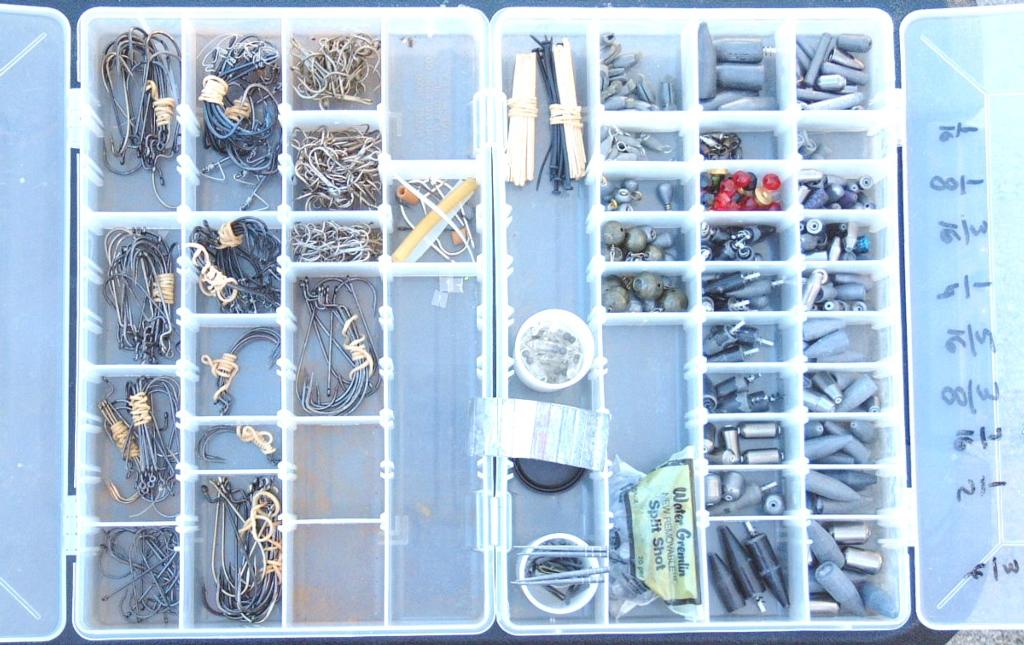Terminal tackle
Nuts-and-bolts tackle should be versatile for bass fishing

Unlike the pros, who carry the entire Walmart fishing aisle in their boat, co-anglers are limited to a tackle pack of their favorite baits. The problem arises when a pro begins to reel bass in on every cast, and the co-angler does not have that particular bait in his or her limited selection.
Fortunately, tournament bass anglers are a fairly decent lot. Most of the time a pro is more than happy to let a co-angler borrow a version of the hot bait, provided that the pro has a few extra in that miniature tackle shop under the deck.
Borrowing spinner baits, crankbaits and even soft plastics is usually not a problem. But co-anglers should not have to rely on pros for terminal tackle.
Terminal tackle is considered the nuts and bolts of bass-fishing tackle: hooks, weights, swivels, beads, rattles, etc.
Most pros probably would not mind lending a co-angler terminal tackle, it’s just expected that you will bring your own nuts and bolts to the project. Additionally, terminal tackle involves a great deal of personal taste and preference that translates into confidence.
A purple worm is a purple worm; however, a pro may like to rig his with a straight shank hook and a pegged bullet weight, and you may like yours with an offset hook and a screw-in weight.
Next to rods and reels, a terminal tackle box is one of the most important fishing items a co-angler carries. That box should be stocked with a complete selection of terminal tackle to handle any situation.
Over the years, I have developed a terminal tackle box that can adapt to nearly any condition a pro can throw at me.
Hooks
Essentially, I use two Plano 3620 boxes for terminal tackle. These boxes are small, flat, compact and come with plenty of dividers to organize lots of small items.
I use one box for hooks and one box for weights. For hooks, I carry four different styles of worm hooks: offset, straight shank, extra wipe gap (EWG) and bait clip. For each hook style, I carry 1/0 through 5/0 sizes. Considering I have about seven to 10 of each style and size, I have between 150 and 200 hooks that must have some kind of order.
One trick I use to keep hooks organized is to use rubber bands to keep them bundled in groups. Normally, I use rubber bands on the hooks that I do not use as often.
I also carry plenty of extra treble hooks (Nos. 2, 4 and 6) and spinner-bait trailer hooks with keepers. If I borrow a hard bait or spinner bait from a pro with stock hooks or no trailer hook, I can customize the bait to my standards without bothering the pro for extra hooks.
Weights
Hooks are the easy part; weights are more complex. These days it takes a degree in metallurgy to understand all the weights needed to bass fish.
Just in terms of weight styles, there are bullets, screw-in bullets, barrels, split shots, mojos, drop-shots, nails and even stick-on weights. Each one of these styles has as many as 10 sizes. Then consider the new tungsten weights, and suddenly getting a worm to the bottom becomes an engineering project.
Managing such an assortment of weights need not be difficult. Simply use the dividers to make spaces for each size of weight: 1/16, 1/8, 3/16, 1/4, etc. I have two separate compartments for each weight size. For example in the 3/16-ounce slot, I have two compartments. I put bullets in one and screw-in bullets in the other.
Besides for bullets and barrels, the other types of weights I carry are drop-shot, split shot, nail and stick-on weights.
Nail weights are inserted into Flukes or Senkos for a faster fall. Stick-on weights, like Storm’s SuspenStrips, are great for quickly modifying jerkbaits and crankbaits into “suspending” baits.
The most versatile weights I carry are 1/8-ounce rubber-core sinkers. These clamp-on weights with a rubber core are a co-angler’s best friend. The modifications that can be made with these sinkers are numerous. I remove the rubber core and clamp them on spinner baits, jigs and the hook shanks of soft jerkbaits for expedient weighting. I have also used them to make makeshift mojo rigs.
Toothpicks and rubber inserts, called “T-stops” by some anglers, are great for pegging weights. The stretchy rubber inserts that look like nails are pulled through the weight to snug the weight to the line.
Rattles are also a co-angler’s best friend. A rattle stuffed inside a tube or lizard can add a little extra noise to the bait and a little extra confidence to the mind.
A good terminal box should also contain the beads, swivels and weights needed to make Carolina rigs. Film canisters make efficient containers for these tiny items.
With a well-stocked selection of terminal tackle, a co-angler can quickly adapt to changes in techniques without having to bug a pro to death for tackle.
Related links:
The Co-angler’s Clinic: Get the Net!
The Co-angler’s Clinic: Packing a manageable amount of tackle
The Co-angler’s Clinic: The importance of the pre-tournament meeting
The Co-angler’s Clinic: Arriving at the tournament site
The Co-angler’s Clinic: Packing for a fishing tournament means careful planning
The Co-angler’s Clinic: Analyzing the amateur experience